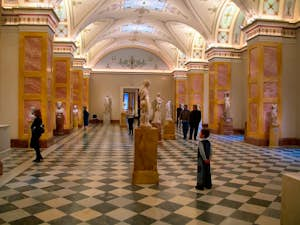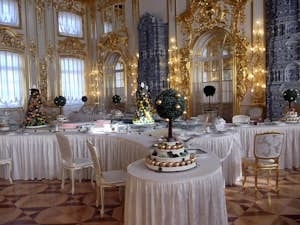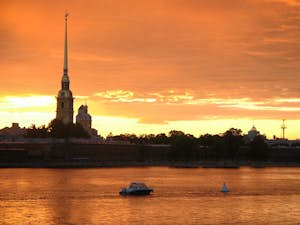Welcome to St. Petersburg, for many the most beautiful city in all of Russia, which embodies the characteristics of a European capital while maintaining a strong national identity. A very popular destination much loved by tourists for its romantic canals and the cultural beauty of the historic center. In June it hosted the 2018 Football World Cup but "Piter", as its citizens like to call it, is worth a visit at any time of year. Let's discover what to see and things to do in St. Petersburg and the main points of interests in the enchanting city of the Tsars.
- St. Petersburg Useful Information: Visa, euro exchange and street signs
- How to get a Visa for Russia?
- Where to exchange Euro to Rubles?
- Street info and language
- White nights in St. Petersburg
- What are White Nights?
- Visit St. Petersburg: Must-see Attractions
- Winter Palace and Hermitage
- Gardens and Catherine's Palace
- The Cathedral of the Saviour on Spilled Blood
- Peterhof Palace, Nevsky Prospect and other points of interest
- What to do in St. Petersburg: Nightlife and leisure
- How to get around St. Petersburg
St. Petersburg Useful Information: Visa, euro exchange and street signs
Keep in mind that you will need the tourist visa for Russia to visit St. Petersburg.
How to get a Visa for Russia?
On the web you will find the necessary documentation to apply for a visa, but if you are not practical you can contact an agency that will handle that. The costs of operations vary depending on your decision to do it by yourself or to contact a Visa Center for Russia (regardless of your choice, please note that the approximate cost of the operation will NOT be less than 100€ at least).
Where to exchange Euro to Rubles?
During your trip in St. Petersburg you will need to change euros into rubles (100 rubles equals about 1.50€ - Update data 2018). You will find numerous bank branches for exchange at the airport, in museums, in metro stations and in the large shops in the city centre, but you should avoid them because of the very inconvenient rates.
- The tip is to change in the many offices / exchange agencies that you find along Nevsky Prospect or its side streets, after checking the scoreboards displaying the daily rate.
- Generally the commission is about 25 or 30 rubles per transaction.
Withdrawing at the airport could be easier, but always keep in mind the extra commissions applied.
- As it often happens during big events, if you are in St. Petersburg for the World Cup, pay attention to fake ATMs that are no longer in use and avoid strangers offering their help to exchange money.
As a general rule, better avoiding to go around with too much cash if you take the bus and metro, especially on Nevsky Prospect, the summer pickpocket mecca. Always prefer to pay by credit card at the hotel, the restaurant, to the museums and shops.
Street info and language
Street signs and subway maps are in Cyrillic but you will also find bilingual signs with directions in English. Except for a few hotels and restaurants/bars, the English language is little spoken, especially among people of a certain age. It is a super feasible trip and you can manage to explain yourself with hand gestures without problems.
- For some specific information, maybe contact the younger people you meet, certainly more likely to communicate in English.
White nights in St. Petersburg
In the period between June and July St. Petersburg hosts the natural phenomenon of the White Nights, an appointment very felt and lived in the city. Every year St Petersburg White Nights attract tourists from all over the world. Thanks to the particular geographical position of the Russian city, for about 50 days the sun never seems to set and the night shows wonderful plays of light; the phenomenon of White Nights repeats cyclically every summer: it starts in the last days of May and reaches its peak after mid-June until the first days of July.
- These are the best months to visit St. Petersburg but it is also the time of year when the city is stormed by tourists, which results in prices rising. The advice is to book well in advance flight and accommodation in St Petersburg.
What are White Nights?
The natural phenomenon of the White Nights of St Petersburg is celebrated by open-air festivals, musical events and, in particular, with the opening of drawbridges, a show that makes the city fascinating and evocative at different times, especially in night hours until the morning. Built on water as Venice, the Russian city is a real "Museum of Bridges" and there are over 300 of them, 20 of which are mobile.
You can admire the opening of the bridges free of charge by placing yourself in some strategic points of the city as the arrow of the island of Vasilievsky, from Dvortsovaya riverfront or from the side of Palace Square (always go there in advance to take your place since there are a lot of people at any time); another valid option is to enjoy the show from the boats organizing special tours and private excursions at night.
Have your camera ready and immortalize the St. Petersburg spectacle magically illuminated at night!
Visit St. Petersburg: Must-see Attractions
In addition to the wonder of the White Nights, in St. Petersburg there is much more to see including historical residences, architectural masterpieces and cultural sites recognized as a UNESCO World Heritage Site.
Winter Palace and Hermitage

The visit winds along a path through magnificent palaces and can last an entire morning if not a day.
Given the length of the route (about 24 KM) you may happen to move from one building to another without even realizing that, so the visit can be dispersive if carried on independently and in the confusion you risk to skip some key art masterpiece.
The main collections are located in the Winter Palace but you should not miss to visit the incredible ones hosted in the Small Hermitage, Old Hermitage, New Hermitage and the Staff Building. Just a few names: Raffaello, Canaletto, Michelangelo, Canova not to mention the entire collection of Impressionist and Post-Impressionist art and the rooms of the great Italian and Flemish painters.
For a complete stress-free experience we advice to buy the ticket with audio guide included (available in English) and valid for two days so as to divide the visit in 48 hours.
- If you want to plan your visit independently without the help of a guide, study the location of the works through the information on the official website of the Hermitage and establish which one you want to give priority.
Best time to visit the Hermitage? In the afternoon from 16:00 onwards.
By purchasing the online ticket you skip the line and the entrance is very fast from a side zone. The online tickets entrance is located in the alley on the left, in front of the main entrance; it is easy to find, you can't miss it! For a extensive tour buy also the audioguide in English (it costs a few more euros but it offers a detailed and satisfactory explanation).
- If you do not hold a ticket, the alternative to avoid the queue at the box office is to buy your entry for the museum by using credit card at the automatic machines, placed at the entrance on the left.
- If you want to opt for a quick tour, choose to visit the Hermitage on a closing day at 21.00 (Wednesday and Friday) and enter the Palace around 18.00. This will allow you greater peace of mind during the visit and to enjoy the best known works, usually surrounded by hordes of tourists in the morning.
There are different types of guided tours to all the Hermitage buildings, organized in one or more days.
SKIP THE LINE TICKETS AND TOUR OF THE HERMITAGE
Visiting the Hermitage with family: strollers and accessibility
Such is the beauty of the Hermitage that every child should visit it. The museum's size, the crowds and the staff speaking Russian only, may make this experience very demanding for those travelling with small children in pushchairs. In terms of accessibility, wheelchair users and those with walking difficulties can move around without problems thanks to the lifts inside the structure.
How to get to the Hermitage
The St. Petersburg Hermitage is located in the city centre and can be easily reached by metro (purple Line 5) with a stop at the Admiraltejskaja station. In addition to the Hermitage, this stop serves other famous attractions of the city such as the Cathedral of St. Isaac, the Bronze Knight or the artificial island of New Holland.
Gardens and Catherine's Palace

The sequence of rooms will fascinate you with their suggestive decorations and the beauty of the gardens surrounding the palace will immerse you in the sumptuous life of the Tsars for a day.
The Amber Room is worth the price of the ticket on its own but also the other rooms such as the Green Dining Room designed by architect Cameron are worth it no less.
Tickets for the Palace can be made on the spot the same day you decide to visit it but especially in the summer we absolutely recommend you to buy them in advance, even if you are obliged to choose the day of the visit at the time of booking.
The building, in fact, opens at 12:00 and at that time a long queue has already formed at the box office; entry to the ticket office is allowed for small groups to avoid crowds, so the queue is very long and you could spend several hours in the line.
Given that the airport is nearby Catherine's Palace, the visit to it may be your last stop in Russia before the flight.
How to get to Catherine's Palace
You can get there by taxi or public transport: take the metro to Moskovskaya (20 min. from Nevskij Prospekt, the main street of St. Petersburg) and then from there the bus 545 (about 40 min. journey). Just let the driver know that your destination is "Catherine Palace" and he will notify you when you arrive at your destination.
The Cathedral of the Saviour on Spilled Blood

Its monumental façade will impress you. Also, the highlight of the Church is the incredible collection of mosaics, colors and representations that cover every millimeter of the interior walls. The ticket is not expensive, if you can not buy it online we recommend you buy it at the vending machine next to the checkout to avoid the queue (the machine accepts both cash and credit cards).
A tip? Go there early in the morning, even around 9:00 a.m., so as not to get crowded. The building is closed on Wednesdays.
The Cathedral of St. Isaac, the largest Russian Orthodox Church St Petersburg, transformed into a museum, is another must-see attraction in the city. The external colonnade is really impressive, we also recommend the climb to the gold dome which offers, behind a small surcharge, a wonderful panoramic view of the historic center of St. Petersburg.
- The view from the Dome is of wonderful beauty. Keep in mind that you have to climb a spiral staircase with over 200 steps to get to the top.
Peterhof Palace, Nevsky Prospect and other points of interest
Another not to miss landmark on a trip to St. Petersburg is the Peterhof complex, one of the seven wonders of Russia, that offers a picturesque view of the Gulf of Finland. The residence is of a unique beauty, considered by many even more beautiful than the Palace of Versailles. Access to the Lower Gardens is subject to a fee, while the Upper Gardens are free. Access to all the other small museums in the gardens, including the Main Palace, requires to purchase separate tickets.
- The gardens are wonderful, the part of the structure not to miss. If you are not sure about which tickets to buy, put at the top of your must-see list, the visit to the gardens and to the Palace.
Peterhof is about 40 km from St. Petersburg but can be easily reached by an efficient bus, train and hydrofoil service.
If you like to stroll in the city center, take a walk along the entire Nevsky Prospect, the main street of the city, and enjoy the majesty of the buildings surrounding it. Don't miss a trip to Arts Square, where the monument to Aleksandr Sergeevič Puškin stands, or to New Holland Island with its characteristic arched door.
- Things to do out from the city centre: take a walk in the flea market of Uldenaya (you can reach it through the blue metro line to Uldenaya) and immerse yourself in the colorful banquets of the city.
- Do you have a strong stomach? Book a trip to Kunstkamera, the ethnographic museum founded by Peter the Great with a collection of all kinds of oddities.
What to do in St. Petersburg: Nightlife and leisure
After a day spent at the museum, what does "Piter" offer for an evening of fun? One of the main streets of St. Petersburg is Rubinstein Street, full of cafes and restaurants located right in the center. The street is not really very long but the large number of bars and clubs concentrated here means that the area is the heart of the city nightlife. If you are at Nevsky Prospect, you can walk less than 5 minutes to reach Rubinstein Street.
A gem where you can stop for lunch or an aperitif just a few steps from the center? As a "top" address we recommend the Loft Project Etagi, one of the largest multifunctional centers in St. Petersburg built in a former bakery. The building hosts exhibitions and art galleries, a hostel with colorful rooms where you can stay overnight, a cafeteria and a roof terrace from which to enjoy a panoramic view of the city. Loft Project Etagi is less than a 20-minute walk from Nevsky Prospect.
How to get around St. Petersburg
Unlike the capital Moscow, 3 or 4 days are enough to visit St. Petersburg and the city can be easily visited alone without any problem. If you prefer to travel by public transport, consider that the city is well served by bus, metro and train.
If you choose to travel and visit the city by underground transport, the advice is to buy a prepaid metro card and load an amount chosen by you, based on the number of trips to be made (bear in mind that the individual trip costs 45 rubles, about 0.65 €). On buses, tickets can be purchased directly on board from the ticket-maker (the ticket costs 40 rubles).
Another valid alternative to visit St Petersburg independently is the taxi, a very used means of transport in St. Petersburg given the low costs. The drawback is that the streets are often paralyzed in traffic in rush hours, so the taxi is more convenient in the evening. The easiest travel option during the day remains the subway, especially to cover long distances.


















